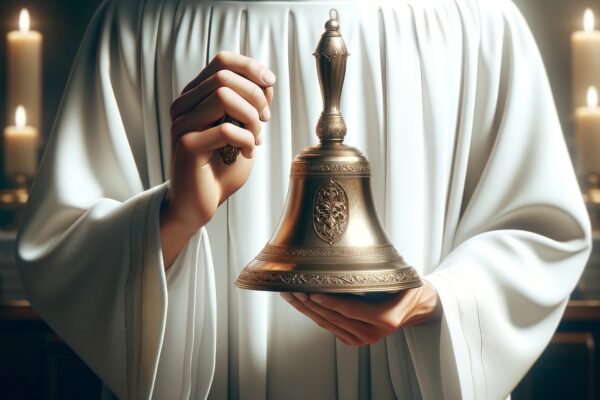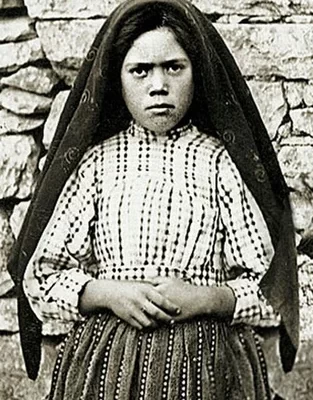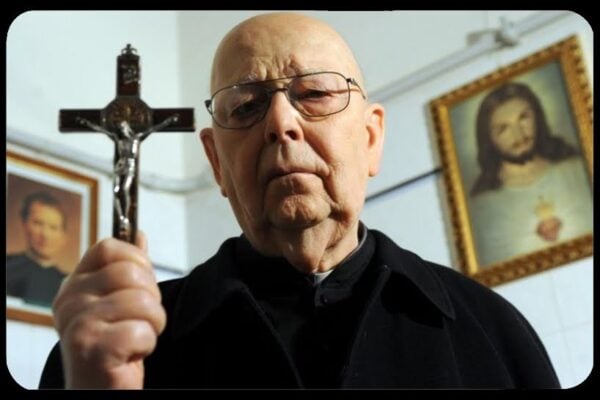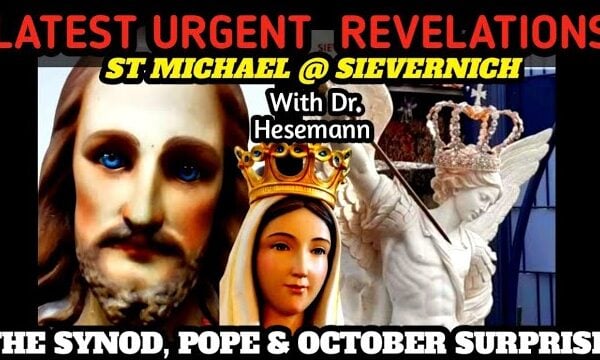
2024


Know Theology |Why Do Catholic Churches Ring Bells During Communion?
Catholic Theology Series The ringing of bells during Catholic Mass holds a profound significance that transcends mere auditory stimulation. It is a practice deeply rooted in tradition, symbolism, and practicality. The melodic chimes of the bells resonate through the sacred space, serving as a poignant reminder of the spiritual journey undertaken during the Communion service. Understanding the historical, symbolic, and practical aspects of this tradition provides a deeper appreciation for its role within the Catholic faith. In the following sections, we will delve into the historical significance of bells in Catholic tradition, explore the symbolism of bells during Communion, examine the practical reasons for ringing bells during this sacred rite, and consider the controversies and variations in bell-ringing practices. Through this exploration, we aim to unravel the layers of meaning behind the resonant echoes that fill the air during the holiest moments of the Catholic Mass. Symbolism of bells during Communion The ringing of bells during the Communion service holds profound symbolism within the Catholic tradition, infusing this sacred rite with layers of spiritual significance. As the faithful gather to partake in the Eucharist, the melodious peal of the bells serves as a poignant symbol of spiritual awakening and divine presence. At the heart of the symbolism lies the notion of transition and transformation. The Communion service represents a pivotal moment in the liturgical journey, where ordinary elements are imbued with extraordinary significance. The bread and wine, through the act of transubstantiation, are believed to become the body and blood of Christ. The ringing of bells at this juncture serves as a sonic herald, announcing this miraculous transformation and calling the faithful to bear witness to the sacred mystery unfolding before them. Moreover, the bells serve as a call to attentiveness and reverence. As the celebrant elevates the consecrated host and chalice, the chiming of the bells draws the congregation’s focus to the altar, directing their hearts and minds towards the awe-inspiring reality of Christ’s presence. The resounding echoes of the bells create a sacred pause, inviting the faithful to enter into a moment of profound contemplation and adoration. Furthermore, the bells symbolize the unity of the Church, both earthly and heavenly. The harmonious resonance of the bells reverberates through the sacred space, transcending earthly confines and echoing into the realm of the divine. This ethereal connection serves as a reminder of the communion of saints, encompassing the living and the departed in a symphony of faith and devotion. In essence, the symbolism of bells during Communion encapsulates the spiritual depth and transcendent beauty of this sacred sacrament. The melodic peals resound as a testament to the profound mysteries of the Eucharist, inviting the faithful to embrace the transformative power of Christ’s presence and to unite in reverence and adoration. Through the timeless symbolism of the bells, the Communion service becomes a symphony of faith, weaving together the earthly and the divine in a tapestry of sacred significance. Practical reasons for ringing bells during Communion The practical reasons for ringing bells during the Communion service are deeply rooted in the rich tapestry of Catholic liturgical tradition. While the symbolic and spiritual dimensions of bell-ringing are profound, there are also practical considerations that underpin this time-honored practice. One practical reason for ringing bells during Communion is to capture the attention of the congregation. The chiming of the bells serves as an auditory cue, drawing the faithful into a moment of heightened awareness as the celebrant elevates the consecrated host and chalice. In the midst of the sacred liturgy, where the senses are engaged in acts of worship, the pealing of the bells provides a focal point, guiding the congregation’s reverence towards the pivotal moments of the Eucharistic celebration. Furthermore, the use of bells during Communion serves a practical function in creating a sense of solemnity and reverence. The gentle resonance of the bells permeates the sacred space, enveloping the congregation in an atmosphere of hushed contemplation. This auditory backdrop enhances the overall ambiance of the liturgical setting, fostering an environment conducive to prayerful reflection and spiritual communion. Additionally, the practical significance of bell-ringing lies in its ability to unify the faithful in a shared experience of worship. The reverberating tones of the bells serve as a unifying force, harmonizing the collective consciousness of the congregation as they bear witness to the sacred mysteries unfolding before them. This communal act of listening to the bells creates a sense of cohesion, binding the faithful together in a shared moment of spiritual resonance and contemplative engagement. Moreover, the practicality of using bells during Communion extends to the realm of tradition and continuity. Across generations, the ringing of bells has become an enduring hallmark of the Eucharistic celebration, linking the present-day faithful to the timeless rituals of the Church. This continuity of practice serves to connect the faithful to the broader tapestry of Catholic tradition, fostering a sense of historical rootedness and spiritual continuity. In essence, the practical reasons for ringing bells during Communion encompass the facilitation of attentiveness, the creation of a reverent atmosphere, the fostering of communal unity, and the preservation of tradition. These practical considerations, intertwined with the spiritual and symbolic dimensions of bell-ringing, contribute to the multi-faceted richness of the Communion service, elevating it to a profound expression of faith and worship. Read More…

Why Sr. Lucia did not see the Miracle of the Sun at Fatima
While a large group of people witnessed the sun “dance” on October 13, 1917 near Fatima, Portugal, the three shepherd children did not see the miracle. Sr. Lucia explains in her memoirs that the visionaries saw a different apparition. After our Lady had disappeared into the immense distance of the firmament, we beheld St. Joseph with the Child Jesus and Our Lady robed in white with a blue mantle, beside the sun. St. Joseph and the Child Jesus seemed to bless the world, for they traced the Sign of the Cross with their hands. When, a little later, this apparition disappeared, I saw Our Lord and Our Lady; it seemed to me to that it was Our Lady of Sorrows (Dolors). Our Lord appeared to bless the world in the same manner as St. Joseph had done. This apparition also vanished, and I saw Our Lady once more, this time resembling Our Lady of Carmel. This vision was only seen by the children, while the crowd was witnessing the sun “dance.” It is believed that the “dancing sun” was meant to inspire belief in the unbelieving crowd, while Our Lady had a different message for the visionaries. Read more…

Fr. Gabriele Amorth’s Deliverance Prayer
O Jesus our Savior, my Lord and my God, my God and my all, with your sacrifice on the Cross you redeemed us and defeated the power of Satan. I beg you to deliver me from every evil presence and every evil influence. I ask you in your name, I ask you for the sake of your wounds, I ask you for the sake of your blood, I ask you for the sake of your Cross, I ask you through the intercession of Mary, Immaculate and Sorrowful. May the blood and the water that flow from your side wash over me to purify me, deliver me, heal me. Amen.

Latest Urgent Revelations from St. Michael! With Dr. Hesemann
Join Dr Michael Hesemann for the latest news and information about the private revelations in Sievernich Germany.

Reading This Will Stop You from Committing Sin! Sufferings of Hell, Revealed to a 20th Century Mystic!
Hell is a real place. But what is it like exactly? While the Bible gives us some clues, the 20th century mystic St. Faustina received a particularly vivid vision, which she recorded in her diary. Note that such “private revelations” are not on the same level of the divine revelation given by God in Jesus Christ. Catholics are not obliged to believe private revelations – but they can nonetheless aid someone in their faith. “Today I was led by an Angel to the chasms of hell,” St. Faustina writes in her diary (741). “It is a place of great torture; how awesomely large and extensive it is!” “The kinds of tortures I saw…” she begins, and then lists the seven kinds of sufferings of hell she saw: “The first torture that constitutes hell is the loss of God; “The second is perpetual remorse of conscience; “The third is that one’s condition will never change; “The fourth is the fire that will penetrate the soul without destroying it – a terrible suffering, since it is a purely spiritual fire, lit by God’s anger; “The fifth torture is continual darkness and a terrible suffocating smell, and, despite the darkness, the devils and the souls of the damned see each other and all the evil, both of others and their own; “The sixth torture is the constant company of Satan; “The seventh torture is horrible despair, hatred of God, vile words, curses and blasphemies.” Read more…



